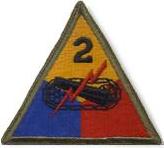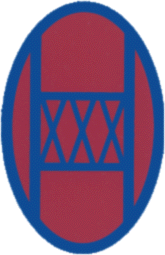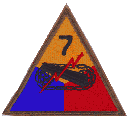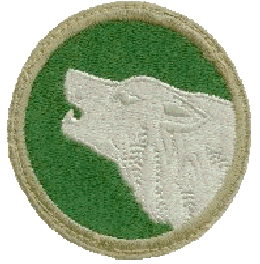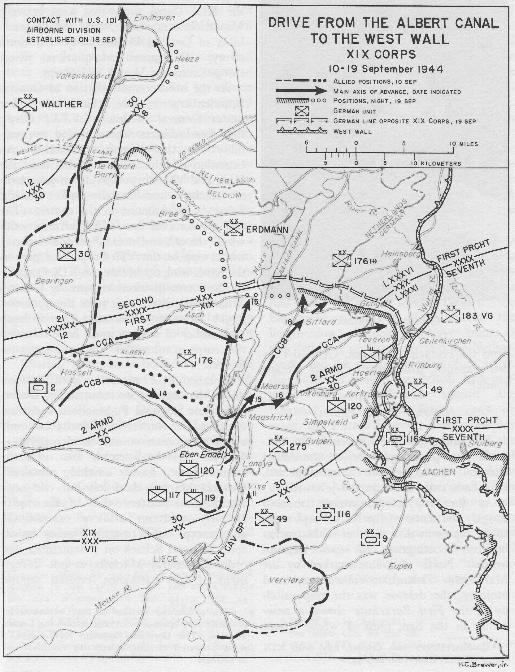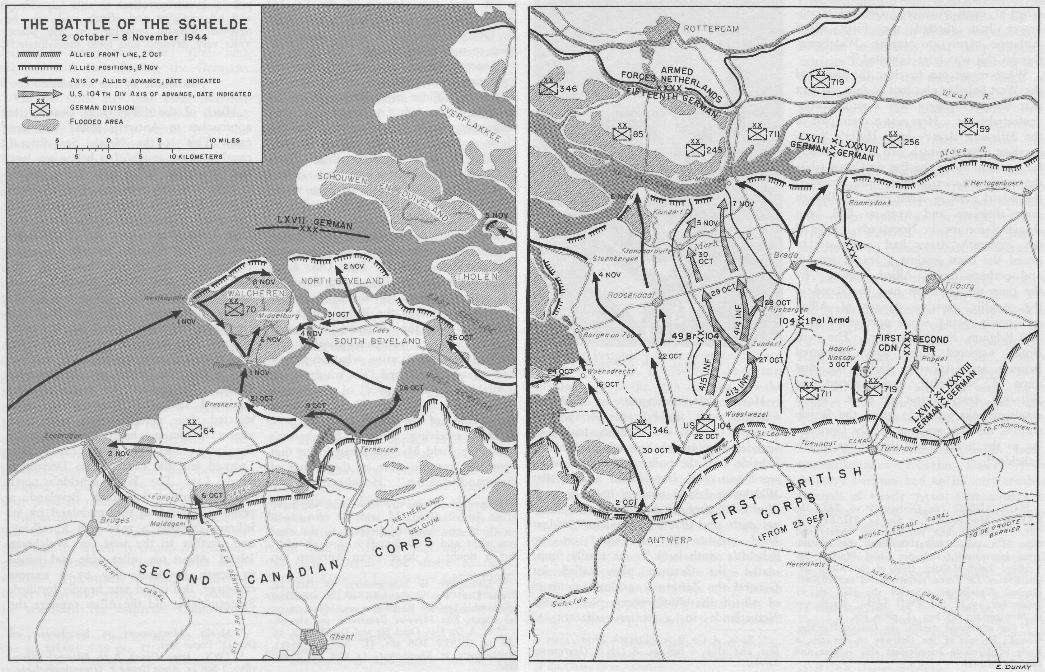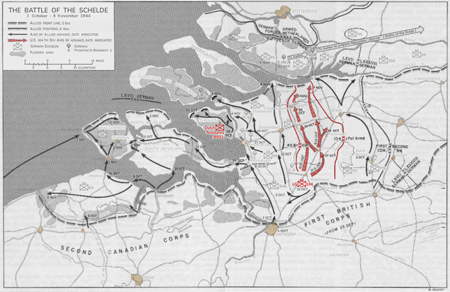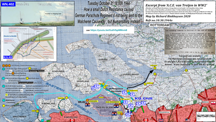7th Armored Division in the Peel Marshes
of the Southeast the Netherlands
in the Netherlands 30 September - 17 December 1944
in combat in the Netherlands 30 September - 7 November 1944
30 September - 8 October: XIX Corps, First US Army
8 October - 8 November: 8 Corps, Second British Army
9 November - 17 December: XIII Corps, Ninth US Army
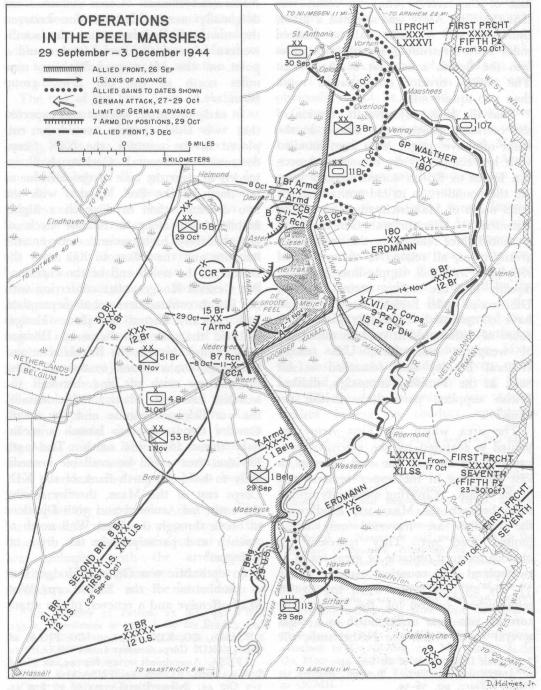
Click on the map for a larger version.
Click here for related text "The Peel Marshes".
First Burials at Margraten: November 10, 1944
On the afternoon of November 10, 1944, the first burials took place in the new temporary U.S. Military Cemetery at Margraten, the Netherlands. Troops of the 7th Armored Division's 87th Cavalry Reconnaissance Squadron had arrived in Margraten on November 9, right after the 11-day battle at Meijel, Ospel and Liesel. The 87 Recon men would remain bivouaced at Margraten for another week. But many of those who were buried there that same week remain there still.
It is fitting that, on that afternoon of November 10, two of the first three burials at Margraten were members of 7th Armored Division's 38th Armored Infantry Battalion (38 AIB).
- The first burial, in Section A, Row 1, Grave 1, was Cpl. John D. Singer (33 007 929) of the 29th Infantry Division in XIX Corps [who apparently died in Germany, though I have not been able to verify this].
- The second burial, in Grave 2, was 38 AIB's Pvt. Joseph A. Surowiec of Buffalo, NY, who died November 9 of wounds suffered as a member of Company "A" near Ospel, the Netherlands on November 5. (Pvt. Gordon Loomis, who was wounded with him, died November 6 and was buried at the temporary U.S. Military Cemetery at Henri-Chapelle, Belgium.)
- The third burial at Margraten that November afternoon, in Grave A-1-3, was 38 AIB's Company "A" Pvt. Claudius H. Chappell of Paducah, KY, who had been wounded with Surowiec and Loomis and who, like Surowiec, succumbed to his wounds on November 9. Both Surowiec and Chappell are shown as being buried at 3:30PM that afternoon.
The remains of Singer and Surowiec were later returned to the United States for final burial. Chappell was reinterred in Margraten when it was converted into a permanent US Military Cemetery. Thus Claudius Chappell of Company C, 38th Armored Infantry Battalion, 7th Armored Division has been buried at Margraten longer than anyone else.
Many of the men of 7th Armored Division who had died in battle in the the Netherlands remained unfound at that time. Some of them have since been found, and some of those are now buried in the permanent cemetery that was later established at Margraten. Some of them have never been found and lay there still, in unmarked graves, waiting to be found, still listed as Missing in Action but now having had an administrative Finding of Death.
How did so many men of the 7th Armored Division die in the fields and bogs and swamps of the Netherlands?
The 7th Armored Division had fought across France, liberating Chartres, making the first crossing of that part of the Seine River upstream of Paris, liberating the WWI sites of Chateau-Thierry and Verdun, coming to a crashing halt in the very different terrain of the highly-fortified area of Metz. On September 25, 1944, the Division was transferred from Third US Army in France and sent north to the the Netherlands.
Three periods of combat
7th Armored Division's combat role in the the Netherlands can be broken into three periods, followed by a period out of combat:
- 29 September - 6 October: The Battle for Overloon
- 7 October - 26 October: Action at Griendtsveen - Patrolling Ell-Weert-Meijel-Deurne
- 27 October - 7 November: Battle of the Canals: Ospel-Meijel-Liesel
- 7 November - 17 December: Reorganizing and Retraining (Some elements of 7AD entered combat in Germany in early December, while other elements of the Division remained in reserve across the Dutch-German border in the the Netherlands.)
Still under construction
Links for Further Reading
- "The Peel Marshes"
Chapter 10 of Charles B. MacDonald's 1961 volume "The Siegfried Line Campaign" of the US Army Center of Military History's (OCMH) "U. S. Army in World War II" series
- "Surprise Attack in the Peel Marshes"
This is a study prepared in 1953 by OCMH researcher Lucian Heichler "to complement" Charles B. MacDonald's volume "The Siegrfried Line Campaign" and is referenced in that volume in footnote 27 of Chapter 10 on page 243. It is a study of the German point of view on their counter-attack that began 27 October in the Nederweert-Meijel-Liesel area of the the Netherlands. It relies heavily on captured German records and on post-war interviews of German officers, especially Gen. Luttewitz, who commanded the German XXXXVII Corps that made the attack.
- 7th Armored Division Document Repository Web Page
Transcriptions of World War II Documents Relating to US 7th Armored Division - thousands of pages of original documents and secondary sources -- arranged by month -- includes more than just 7th Armored Division documents but is focused on 7th Armored Division actions
- 7th Armored Division "Battle of Canals"
Transcribed, introduced and annotated book about the 7th Armored Division in the battle from 27 October - 7 November at Meijel (and the area from Nederweert and Ospel to Asten, Liesel, and Neerkant)
- 82nd Engineer Combat Battalion
A/82 and C/82 were attached to 7AD on September 27 and participated in the attack on Overloon until October 6. B/82 was attached to the 113th Cavalry Group in the attack north of Sittard, September 29 - October 4.
- Monument at Ospel
On May 26, 2007, a new monument was dedicated at Ospel to contain the names of men of the U. S. 7th Armored Division who died in the immediate area of the small town of Ospel.
- Monument at Overloon
On September 27, 2008, a new monument was dedicated at Overloon to the men of the U. S. 7th Armored Division who died in the liberation of Overloon.
- Monument along Kamphoefweg, just west of Overloon
On October 10, 2009, a new monument was erected, which was dedicated November 8, 2009, to George Renda and Aloysius Gonsowski, at the location where their remains were discovered in 1977.
- Memorial Plaque at Ransdaal
On November 27, 2008, a new memorial plaque was dedicated at Ransdaal to the Richard Knott of the U. S. 7th Armored Division who was accidentally killed at Ransdaal.
- Oorlogsslachtoffers Deurne - Online memorial to all WWII dead in and from Deurne
Entry page (Dutch)
Main page (computer-generated English translation)
|
